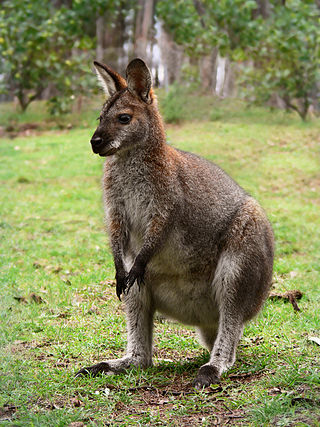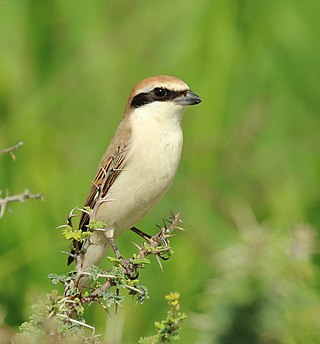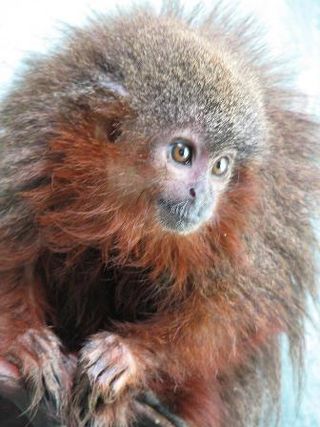
Kangaroos are four marsupials from the family Macropodidae. In common use the term is used to describe the largest species from this family, the red kangaroo, as well as the antilopine kangaroo, eastern grey kangaroo, and western grey kangaroo. Kangaroos are indigenous to Australia and New Guinea. The Australian government estimates that 42.8 million kangaroos lived within the commercial harvest areas of Australia in 2019, down from 53.2 million in 2013.

Hawks are birds of prey of the family Accipitridae. They are very widely distributed and are found on all continents except Antarctica.

Opossums are members of the marsupial order Didelphimorphia endemic to the Americas. The largest order of marsupials in the Western Hemisphere, it comprises 93 species in 18 genera. Opossums originated in South America and entered North America in the Great American Interchange following the connection of North and South America.

A wallaby is a small or middle-sized macropod native to Australia and New Guinea, with introduced populations in New Zealand, Hawaii, the United Kingdom and other countries. They belong to the same taxonomic family as kangaroos and sometimes the same genus, but kangaroos are specifically categorised into the four largest species of the family. The term "wallaby" is an informal designation generally used for any macropod that is smaller than a kangaroo or a wallaroo that has not been designated otherwise.

The macaques constitute a genus (Macaca) of gregarious Old World monkeys of the subfamily Cercopithecinae. The 23 species of macaques inhabit ranges throughout Asia, North Africa, and Europe. Macaques are principally frugivorous, although their diet also includes seeds, leaves, flowers, and tree bark. Some species such as the long-tailed macaque will supplement their diets with small amounts of meat from shellfish, insects, and small mammals. On average, a southern pig-tailed macaque in Malaysia eats about 70 large rats each year. All macaque social groups are arranged around dominant matriarchs.

The long-tailed skua or long-tailed jaeger is a seabird in the skua family Stercorariidae.

The red-tailed hawk is a bird of prey that breeds throughout most of North America, from the interior of Alaska and northern Canada to as far south as Panama and the West Indies. It is one of the most common members within the genus of Buteo in North America or worldwide. The red-tailed hawk is one of three species colloquially known in the United States as the "chickenhawk", though it rarely preys on standard-sized chickens. The bird is sometimes also referred to as the red-tail for short, when the meaning is clear in context. Red-tailed hawks can acclimate to all the biomes within their range, occurring on the edges of non-ideal habitats such as dense forests and sandy deserts. The red-tailed hawk occupies a wide range of habitats and altitudes, including deserts, grasslands, coniferous and deciduous forests, agricultural fields, and urban areas. Its latitudinal limits fall around the tree line in the subarctic and it is absent from the high Arctic. Generally it favors varied habitats with open woodland, woodland edge and open terrain. It is legally protected in Canada, Mexico, and the United States by the Migratory Bird Treaty Act.

Halictidae is the second-largest family of bees with nearly 4,500 species. They are commonly called sweat bees, as they are often attracted to perspiration. Halictid species are an extremely diverse group that can vary greatly in appearance. These bees occur all over the world and are found on every continent except Antarctica. Usually dark-colored and often metallic, halictids are found in various sizes, colors and patterns. Several species are all or partly green and a few are red, purple, or blue. A number of them have yellow markings, especially the males, which commonly have yellow faces, a pattern widespread among the various families of bees. The family is one of many with short tongues and is best distinguished by the arcuate basal vein found on the wing. Females in this family tend to be larger than the males.

The white-tailed deer, also known commonly as the whitetail and the Virginia deer, is a medium-sized species of deer native to North America, Central America, and South America as far south as Peru and Bolivia, where it predominately inhabits high mountain terrains of the Andes. It has also been introduced to New Zealand, all the Greater Antilles in the Caribbean, and some countries in Europe, such as the Czech Republic, Finland, France, Germany, Romania and Serbia. In the Americas, it is the most widely distributed wild ungulate.

The fat-tailed gerbil, also called the duprasi gerbil or doop, is a rodent belonging to the subfamily Gerbillinae. It is only species in the genus Pachyuromys. They are frequently kept as pets.

The long-tailed paradigalla is a large, approximately 37 cm long, black bird-of-paradise with long and pointed tail. One of the most plain members in the family Paradisaeidae, its only adornment is the colorful facial wattles of yellow, red and sky-blue near base of the bill. Both sexes are similar in appearance, however the female is slightly duller and smaller.

The ring-tailed vontsira, locally still known as the ring-tailed mongoose is a euplerid in the subfamily Galidiinae, a carnivoran native to Madagascar. It is the only species in the genus Galidia.

Callahan State Park is a public recreation area covering 958 acres (388 ha) mostly in Framingham and Marlborough, Massachusetts, with a small section in the adjoining town of Southborough. The state park is managed by the Department of Conservation and Recreation.

The Angolan slender mongoose is a mongoose native to southwestern Africa, specifically southwestern Angola and northwestern Namibia. It has been listed as "Least Concern" on the IUCN Red List, as it is not threatened and thought to be common. It has a long, slim body and there are different colour forms, a black or dark brown form in the southern part of its range, and a yellowish- or reddish-brown form in the north. This mongoose inhabits dry, rocky habitats and feeds on insects, scorpions and small vertebrates.

The red-tailed phascogale, also known as the red-tailed wambenger, red-tailed mousesack or kenngoor, is a small carnivorous marsupial found in inland areas of south-western Western Australia, and has been reintroduced in sanctuaries in WA and the Northern Territory. It is listed as near threatened by the IUCN Red List, vulnerable under the federal EPBC Act, and its status varies between extinct and conservation-dependent under respective legislation in other states and territories of Australia.

The black-and-red broadbill is a species of bird in the typical broadbill family, Eurylaimidae. It is the only species in the genus Cymbirhynchus. A large, distinctive bird, it has maroon underparts, black upperparts, a maroon neck-band, and white bars on the wings. It also has a large, two-colored, blue-and-yellow bill. The species shows slight sexual dimorphism, with females being smaller than males. No other bird in its range resembles it, though the black-and-yellow broadbill has a similar call.

In biology, Lipotriches is a large genus of sweat bees in the family Halictidae, distributed widely throughout the Eastern Hemisphere though absent from Europe. There are nearly 200 species in 9 subgenera. They commonly have prominent bands of hair on the margins of the metasomal segments.

The red-tailed shrike or Turkestan shrike is a member of the shrike family (Laniidae). It was formerly considered conspecific with the isabelline shrike and the red-backed shrike.

The Caquetá titi monkey, also known as the red-bearded titi or the bushy-bearded titi, is a species of titi monkey endemic to Colombia found in the Department of Caquetá region. Taxonomically, it is a member of the "Callicebus cupreus group", following Shunsuke Kobayashi's Callicebus grouping. It was first described by Thomas Defler, Marta Bueno and Javier Garcia in 2010. It is highly endangered due to habitat fragmentation and a small population.
Lipotriches notiomorpha is a species of bee in the genus Lipotriches, of the family Halictidae. It is endemic to Sri Lanka, where it was first found from Anuradhapura district.


















